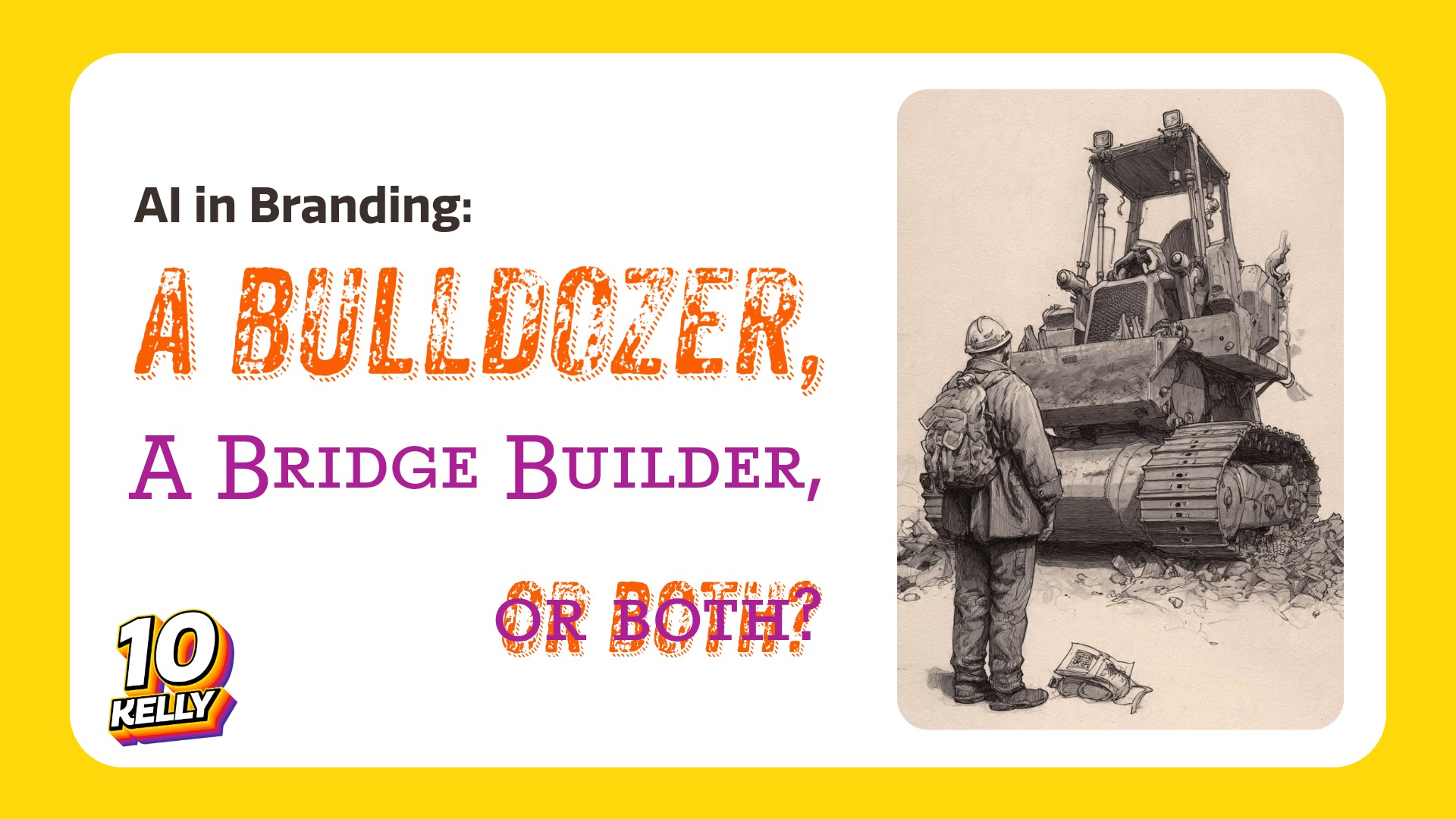Artificial intelligence is everywhere right now. From headline-grabbing tools to the quiet automation now humming beneath your everyday tasks. It’s a powerful, fast, and sometimes a little frightening concept. But AI in branding especially, is not ubiquitous or uniform, despite many tools providing the same outputs. In many ways, AI is like heavy construction equipment. Like a bulldozer, it can reshape the creative landscape in moments. The problem is, not everyone who climbs into the driver’s seat knows what they’re doing.
At 10Kelly, we do not see AI as a threat to us, though many branding and marketing professionals are being put out of work by it. For people who devoted their life to a creative or technical specialization like software development or things of that nature, they may be on borrowed time in their career as an individual unless they can figure out how to use AI to double or triple their own output.
While many people focus in broad strokes on industry trends, we have been leveraging these tools for our own gain as much as possible. That kind of mentality is what we do to stand out, and provide great benefit to our clients too.
When handled responsibly, AI can clear the path for better ideas, sharper design, and smarter branding.
If used recklessly, it can flatten the very foundations of your brand.
How To Use This Bulldozer To Build Bridges
Your mind can not very easily become a totally blank canvas. As human beings, we have things like taste or distaste and preferences which guide our choices. Along the way in creative projects, as artists or producers, we too can become rigid or blinded by repetition. AI can clear the deck, and allow us to create a new starting point.
Picture a construction site. You’ve got blueprints, a vision, and the materials for the job.
But there is a bunch of junk in the way you need to clear out. A bulldozer is essential when you need to move massive amounts of material quickly. In our creative metaphor that also includes the building process itself; because what the AI generates is not going to be the finished form in most branding projects. Once the path is cleared, the AI can provide some of the foundational images or components, but it is up to us as experienced professionals to know when to push, when to pull, and when to stop.
Creativity, Automation, and Clearing A Path with AI in Branding
Many businesses approach AI believing it will replace creativity. What AI can actually do best is accelerate creativity, expand creativity, or open up new possibilities, when guided by strategy, experience, and taste. The danger comes when clients or inexperienced marketers use AI as a shortcut rather than a supplement.
At 10Kelly, AI is an extension of our creative process for branding work. It has in some cases replaced our reliance on outside illustrators, programmers, and other professionals. That is true. So it has made us much more competitive with bigger companies who have much larger overhead.
We use AI to brainstorm visual directions, test messaging variations, analyze audience data, scan websites for responsiveness and accessibility, write custom software for marketing automation and data collection, and so much more.
These are things which would have cost us thousands of dollars years ago, that we now get for the cost of affordable monthly subscriptions.
Many free tier LLM are incredible. That (free or cheap access) may not last.
In practice, AI helps our two-person team work like ten.
It doesn’t replace our expertise – it allows us to multiply our effort. That efficiency translates into more time spent refining details that matter, more capacity to serve clients, and ultimately, better results for everybody.
The Human Element Is Still Steering the AI Branding Machine
The secret to responsible AI use isn’t resistance – it’s leadership.
AI needs human direction. It needs a creative foreman who knows where to dig, when to stop, and how to read the terrain. In fact, it does not produce anything on its own. It is sitting there waiting for you to use it. That is one of the mysteries and new paradigms we are dealing with as human beings.
Taking credit for the output of AI can feel like a misunderstanding. But it’s not.
It would be no different than if I took credit for an employees’ work, in that it was my agency that did it based on my direction. The artist or programmer is talented, capable, but only there working on that project because of us. That control is something that most people struggle with since they have a subservient belief system around human beings and AI.
We are not subservient to anyone or thing, though.
The Future of Creative Work Is By Whatever Means Necessary
At 10Kelly, we see it as our responsibility to dig in and leverage AI however we can. Our clients trust us to use every available tool to elevate their brand, not endanger it. That means using AI thoughtfully. It is silly to imagine attempting to force AI out of our creative process, however, we have been marketing and creating art for decades already. If all the server farms were fried, or if the world forgot how to code machine learning systems, and if AI never again were created, we would still be designing logos the old fashioned way, hand-writing website code, and emailing with amazing copywriting.
That is the kind of leadership you need when taking your brand to the next level or doing anything else in the creative space.
AI can clear the land or destroy the landscape. It depends entirely on who’s operating it. In skilled hands, it becomes a bridge between imagination and execution – turning ideas into polished realities faster than ever before.The challenge – and opportunity – of our era is to learn how to steer the machine. At 10Kelly, we’re doing just that: pairing technology with artistry, precision with passion.

